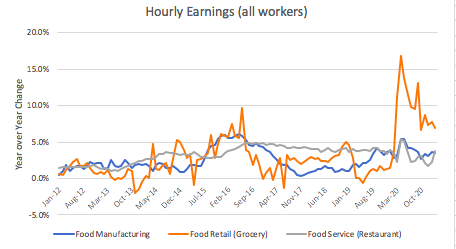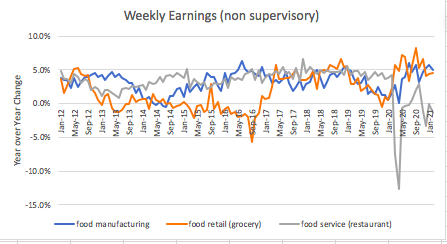Labor Shortage? Data Shows Added Unemployment Payments are Crippling Employers' Ability to Find Workers
USFR 05/08/21 - Farm Journal Report
Restaurants closing early. Sign after sign plastered along roadsides with businesses looking for help. The hiring issue is evident in many regions of the country, crippling everything from manufacturing to the restaurant industry.
“In talking with my guys that do the welding for us in ordering to steel, they said it all goes back to the steel mills,” says Nic Beck of Carks Ag Supply based in Nebraska, a company that produces seed tenders. “It's not a shortage of iron ore. It's not a recycled steel shortage. It comes down to labor.”
And in the Pacific Northwest, farmer Shay Myers is also dealing with a labor shortage. He pushed out a TikTok video that went viral after he pointed out 350 pounds of asparagus that was on the verge of going to waste.
“We can’t get the labor,” he said on the video. “We can’t get people to show up and do the work for $16 an hour, with housing, transportation and all of those things. What we usually do is bring people in on a H2A visa, but the border is so screwed up, that we can’t get people across. So, they are telling us it’s 30 to 45 days before we have laborers in this field to pick this crop.”
While Myers points to the border being the issue for him, the lack of available workers in the U.S. is creating bottlenecks, and it’s driven in part by a shortage of truck drivers.
The California Farm Bureau says during carrot and onion harvests in South California, they are seeing up to 30% fewer drivers than before the pandemic.
“In order to alleviate some of the shortage, we need to get President Biden to enact the Stafford Act, as Donald Trump did last year,” says Joe Antonini, president of Antonini Enterprises. “This would allow the weights of the loads to go from 80,000 pounds maximum to 88,000 pounds, a 10% weight tolerance. Given that, there would be some relief on the amount of drivers needed to bring in the harvest."
The Labor Debate
Purdue University’s Jayson Lusk says there’s not necessarily a shortage of workers in the U.S.
“It's a little perplexing,” says Lusk. “You mentioned the word ‘shortage.’ If you actually looked at data on employment, there's actually a lot fewer workers in the restaurant industry, and a little bit fewer workers in food manufacturing and in grocery retail. So that would seem to suggest, well, we don't really have a shortage.”
The Bureau of Labor Statistics data shows wages and earnings have increased significantly, especially in the grocery and retail food sectors.
“Wages are getting pulled up, so you would think that would pull in more workers into those sectors. But we're not really seeing that at the moment. That's really where this perception of a shortage comes from,” Lusk says.


According to AP on Tuesday, U.S. employers posted a record number of available jobs in March, illustrating starkly the rush of businesses seeking to find new workers as the economy expands. Yet total job gains increased only modestly, according to a Labor Department report issued Tuesday.
JUST IN: WASHINGTON (AP) - U.S. employers posted a record number of available jobs in March. Job openings rose nearly 8%, to 8.1 million in March, the most on records dating back to December 2000. — AgDay TV (@AgDayTV) May 11, 2021
The data comes after the April jobs report last week that fell far short of economist expectations, largely because companies appear unable to find the workers they need. Data that shows it’s not a shortage of workers, it’s a shortage of people willing to work.
“That the natural question: why? Why are people showing back up at work? And I think there are several possible explanations,” he says.
In the latest Kansas City Federal Reserve Manufacturing Report, one manufacturer said, “Stimulus and increased unemployment money are wrecking the labor pool. Lower-level employees are quitting to make just as much not working.”
By the Numbers
The issue is also heating up in Washington, D.C. The Labor Department report on Friday showed 266,000 new jobs were created in April, which was much smaller than the 1 million expected by a Reuters poll. The report also showed a drop in temporary help positions.
Today, someone with a $15-per-hour job, working 40-hour weeks, would bring home $600 a week. However, in Kentucky, the maximum unemployment pay is $569 per week, plus the extra $300 per week passed in the Biden Administration’s American Rescue plan. In Kansas, those who were getting $488 for unemployment before, are now getting $788 with the added federal benefit. The numbers show instead of getting paid to work, some Americans can make more money by simply not working at all.
“I haven't seen empirical estimates of the effect, but it has to be having some effect,” says Lusk. “If people can stay at home and make something similar to what they might at work, that's going to keep people out of the workforce.

The extra $300 per week federal unemployment benefit was extended through the beginning of September as some states are now taking the matter in their own hands. Just last week, Montana's governor announced the state will end its participation in the federal unemployment program, which means unemployed workers will no longer receive the extra $300 per week. Instead, Montana’s governor says the state will launch a new program to provide bonuses to unemployed workers who return to work.
The Biden administration held a press briefing on Friday and dismisses concerns that the added unemployment benefits are causing hiring issues across the U.S.
"It's clear there are people who are not ready and able to go back into the labor force," U.S. Treasury Secretary Janet Yellen said.
The True Cost of Fewer Workers
And as food service employers offer sign-on bonuses or pay more to find people to fill those jobs, basic economics show there’s no such thing as a free lunch as those added costs will get passed on through the menu.
“It gets pushed in both directions,” adds Lusk. “It has a depressing effect on commodity prices, despite the highs we're seeing at the moment, but also is going to result in higher retail food prices. That extra cost in the system is going to ultimately be born - at least in part - by the food consumer.
The labor debacle is coming at a time when commodity prices are also racing higher.
“We are starting to see those higher farm commodity prices show up in higher retail food prices,” says Lusk. “If you just look at the year-over-year change, it doesn't look crazy, it doesn't look outside the norms. But I think the cumulative effect is really starting to appear in the data. And really, over the course of the last year, we're seeing retail food prices starting to tick up quite a bit.”
As corn prices gained $1 in just two weeks, the rise in commodities may not be over yet, as the debate over inflation also heats up.
“At the moment, it looks like those high commodity prices may be with us,” says Lusk. “I think we'll probably continue to see that in our food prices and our meat prices.”
Just last week, wholesale choice beef prices reached prices not seen since the early weeks of the pandemic. With added expenses and labor challenges for those trying to serve customers, it’s making for an expensive and challenging return to normal.







